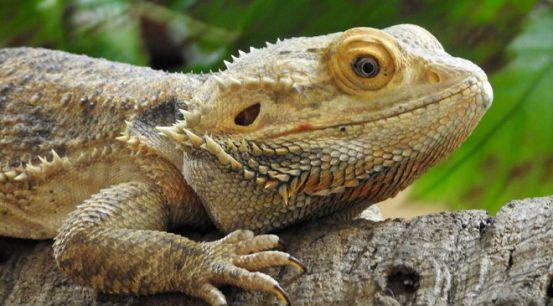Like any other pet, bearded dragons may suffer from both external and internal parasites. Which are some of the internal and external parasites that affect these pets
Internal parasites
Internal parasites spread through contact, contaminated environment and items, infected water, and food.
The most common internal parasites that these pets may have include coccidia and pinworms. Others include protozoans, flagellates, giardia, and tapeworms.

While in perfect health, they are asymptomatic (don’t show any symptoms), and they seem commensal, i.e., the benefit from the lizard, but don’t harm it.
General signs and symptoms
However, if when under stress, sick or have a weakened immunity system, they may show some symptoms which will include the following:
- Foul-smelling poop. It may also appear like it wasn’t well digested and change in color. The color change is not due to diet.
- Diarrhea that may have mucus or blood
- Vomiting with some visible parasites at times
- Lethargy
- A lot of weight loss during brumation
- Dehydration
Diagnosis and treatment
Diagnosis is by considering the patient’s history, symptoms, physical examination, and laboratory tests. Usually, a stool test is the surest way of knowing if your pet has parasitic infestation and which parasites. We recommend annual stool tests such as fecal floatation or smear test
Treatment may include oral or injectable dewormers (anthelmintics) or antiprotozoal agents depending on the specific parasite that your bearded dragon has.
Let us look at a few individual parasites:
Pinworms and other nematodes
Pinworms (Oxyuris spp.) occur on the lower gastrointestinal tract. Treatment is by Fenbendazole (Panacur®) with will work for other roundworms, hookworms, tapeworms, whipworms, and so on. Also, the Nature Zone Reptile Worm Guard Powder.
1. Giardia
This microscopic parasite causes giardiasis that will result in a foul-smelling poop. An antiprotozoal agent like Ronidazole will help treat it.
2. Coccidia
It causes mild to severe diarrhea, refusal to eat, lethargy, weakness, and death. Your vet may prescribe anticoccidial like sulfadimethoxine with brand names like Albon, to treat coccidia.
However, to kill coccidia oocysts, use bleach + water solution, 10% ammonia, or hot steam.
3. Amebiasis
Symptoms will include bloody stool or stool with mucus, dehydration, anorexia, among others. Use Metronidazole to treat it.
4. Internal parasites prevention
To prevent internal parasites, proper disinfection of their terrarium, including all its items such as water bowls, food bowls, furniture, is essential.
Also, ensure regular deworming, regular fecal and wellness test, and quarantining new bearded dragons. Freeze their feeder prey in case you suspect they have parasites.
Finally, while treating them, give these pets Nutribac Dietary supplement or PetAg Bene-Bac. These two probiotics will help restore their healthy gastrointestinal microflora quickly after deworming.
External parasites – ticks and mites
The most common external parasites that your bearded dragons may have are mites and ticks. They can come with a new beardie, crawl from one place to another, or spread by contact.
Ticks and mites bloodsucking arachnids can transmit disease (bacteria, viruses, and parasites like protozoans) and spread from one bearded dragon to another. They will drain your pet’s serum, weakening this reptile, and may make them anemic.
1. Mites and treatment
In the case of mite infestation, you may see them roaming on this pet’s body or tucked on scale edges, especially around ears and eyes, since scales are thinner in these places. They also hide on armpits and neck skin folds.
Signs of mites
- Lethargy
- Itching and rubbing
- Bite marks on their ears, eyes among other areas (tiny red dots)
- Mite poo on your bearded dragon body that appears as ash-like dust.
Treatment
Treatment is by topical, oral, or injectable medicines, as well as disinfecting their habitat. Your vet should guide you on what to use and what not to use. For instance, you can use pyrethroids like Provent-a-Mite, which is EPA and USDA, for treating mites in reptiles, but you need to follow instructions. Otherwise, it will harm your pet.
Your vet may also advise you to use olive oil, a warm soak with Betadine (will fight bite infections as well as help heal bite wounds), ivermectin, cyfluthrin, among other ways to get rid of mites. However, avoid pet strips, including flea collars for cats and dogs.
Secondly, you need to clean, disinfect, sterilize, or treat their environment to avoid reinfection since their pupal, eggs, and egg-laying females will not be on your bearded dragon’s body. Some of the critical cleaning tips include:
- Remove your bearded dragon from its cage
- Disconnect and remove all terrarium fixtures, including heating lamps, thermometers, hygrometers, UV lamps, toys, hammocks, feeding bowls, water bowls, and other décor or enrichments, and so on.
- Microwave any items that won’t burn such as climbing branches or basking rocks at 200-250 degrees Fahrenheit and soak those that can be soaked
- Safely dispose of any substrate you were previously using.
- Wipe and clean your vivarium with bleach and water solution. Use a cup of bleach per two gallons is ok.
2. Ticks
Ticks are often visible. If you can see it, put on your gloves, grab it with forceps at the point where its mouthparts are attached to your pet’s skin, and steadily remove outwards and put it that has alcohol to kill it. Don’t squeeze or smite it.
Afterward, disinfect the affected place to kill any germs, including bacteria that the tick may have left behind.
Finally, your herp vet will guide you on how to use ivermectin, Permethrin, or any other product where necessary. Don’t use any tick product before your vet gives you the go-ahead.
